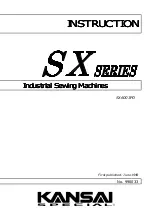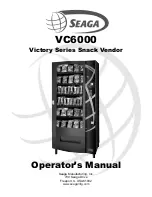
BNP
®
6012 and 7212 SUCTION BLAST CABINETS
Page 19
© 2019 CLEMCO INDUSTRIES CORP.
www.clemcoindustries.com
Manual No. 27723, Rev. B 04/19
Condition of parts being blasted:
Heavily
contaminated parts require more maintenance to
the cabinet’s media recovery system.
Friability of media:
Media that rapidly breaks
down require more maintenance to the cabinet’s
media recovery system and dust collector.
6.1
Daily Inspection and Maintenance before
Blasting with the Air OFF
6.1.1 Check media level:
Check media level in
reclaimer and refill as necessary.
6.1.2 Inspect reclaimer debris screen and door
gasket:
Check reclaimer debris screen for debris. The
screen is accessible through the reclaimer door. With
the exhauster OFF, remove the screen and empty it
daily or when loading media. Empty the screen more
often if part blasted causes excessive debris. Do not
operate the machine without the screen in place;
oversized byproduct from blasting could plug the nozzle.
While the door is open, inspect the door gasket for wear
or damage. Replace the gasket at the first sign of wear.
6.1.3
Drain compressed-air filter:
The cabinet is
equipped with a manual-drain air filter. Drain the filter at
least once a day and more often if water is present.
Moist air inhibits the flow of media. Drain the air line and
receiver tank regularly. If the filter does not remove
enough moisture to keep media dry and flowing, it may
be necessary to install an air dryer or aftercooler in the
compressed-air-supply line.
6.1.4 Inspect dust container:
Refer to the dust
collector owner’s manual and empty dust containers.
Adjust schedule based on refill rate.
6.2
Daily Inspection During Blasting – Have
Someone Do the Following:
6.2.1 Inspect cabinet for dust leaks:
During
operation, inspect cabinet door seals for media leaks.
Dust leaking from the inlet damper or other places on
the cabinet indicates saturated filter cartridge. Refer to
the dust collector owner’s manual.
6.2.2 Check exhaust air for dust:
Dust discharge at
the dust-collector outlet indicates a leaking or damaged
filter cartridge. Check immediately. Note that a small
amount of dust egress is normal for a short time before a
new cartridge is seasoned.
6.2.3 Drain pulse reservoir:
Refer to the dust
collector owner’s manual and drain the pulse reservoir
(manifold) at the end of each shift.
6.2.4 Cartridge pulsing:
Refer to the CDC-1 Dust
Collector manual for pulsing instructions and pulse the
cartridge at least every half hour of blasting and before
turning OFF the exhauster. Dusty blasting conditions will
require more frequent pulsing. RPC-2 and RPH-2 Dust
Collectors are automatically pulsed at timed intervals.
6.3
Weekly Inspection and Maintenance Before
Blasting with Air OFF
6.3.1 Inspect view-window cover lens:
Inspect the
window cover lens. Replace as needed, per Section 7.3.
6.3.2 Inspect gloves:
Inspect gloves for wear. The
first sign of deterioration may be excessive static
shocks. Replace as needed, per Section 7.1.
6.3.3 Inspect BNP
®
Gun Assembly:
Inspect internal
parts of the BNP Gun for wear. Inspection and
replacement of the air jet cover before it wears through
will prolong the life of the jet. Replace parts as needed,
per Section 7.2.
6.3.4 Inspect media hose:
Inspect media hose for
thin spots by pinching it every 6 to 12 inches. Replace
the hose when it becomes soft.
6.4
Weekly Inspection During Blasting – Have
Someone do the Following:
6.4.1 Inspect flex hoses:
Inspect flex hoses for leaks
and wear.
6.5
Monthly Inspection and Maintenance
6.5.1 Reclaimer wear plate and liners:
Remove the
flex hose from the reclaimer inlet and use a light to
inspect the reclaimer wear plate or optional rubber
reclaimer liners for wear. If the rubber is worn through to
the backing metal, replace the wear plate per Section
7.8 or rubber liners per Section 7.9, as necessary.
6.6
Dust Collector
Reverse-pulse dust collectors are covered in a separate
manual. Refer to Section 1.1.1.
















































